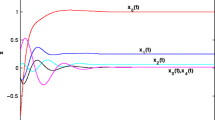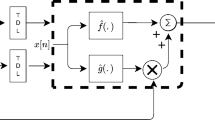Abstract
This paper proposes an identification-based nonlinear control scheme which casts the plant model as a recurrent high-order neural network. The model thus obtained consists on polynomials of a fixed number of nonlinearities, a fact that is exploited by transforming it into an exact tensor-product representation whose nested convex sums may increase with the network order while preserving the number of different interpolating functions. Convexity is then used along the direct Lyapunov method to find conditions for controller design in the form of linear matrix inequalities or sum-of-squares; thanks to the fixed number of nonlinearities, they can be made progressively more relaxed while preventing the computational burden usually associated with Pólya-like relaxations. The control law thus obtained is a generalization of the well-known parallel distributed compensation; its effectiveness is illustrated in academic examples and an internal combustion engine setup.






Similar content being viewed by others
Notes
Usually referred as the premise vector in Takagi–Sugeno (TS) fuzzy contexts [9].
A polynomial p(x) is SOS if there exist polynomials \(f_i(x)\), \(i\in \{1,2,\ldots ,M\}\) such that \(p(x)=\sum _{i=1}^Mf^2_i(x)\).
A RHONN of order r is complete if it contains every possible monomial in \(y_j\) of orders \(1,2,\ldots ,r\) in vector (2).
If the inputs of a RHONN do not pass trough sigmoid functions \(u=\nu \); this is a common practice for affine-in-control systems [43].
Should the origin \(\eta _s=0\) not be in the compact set \({\mathcal {C}}\) due to x being mapped to \(\eta \) and further to \(\eta _s\), it can always be enlarged as to contain it. Recall that Lyapunov theory will otherwise not hold unless a neighbourhood (i.e., \({\mathcal {C}}\)) of the origin is provided.
References
Ogata K (1998) System dynamics. Prentice Hall, Englewood Cliffs, NJ
Quanser I (2006) Mechatronics control kit user’s manual (instructor). Mathworks, inc, Natick, MA
Åström KJ, Wittenmark B (2013) Adaptive control. Courier Corporation, Chelmsford
Ogata K (2001) Modern control engineering. Prentice Hall PTR, Englewood Cliffs, NJ
Wang L (1997) A course in fuzzy systems and control. Prentice Hall Inc, Upper Saddle River, NJ
Utkin V (1992) Sliding modes in control and optimization, vol 116. Springer, Berlin
Khalil H (2014) Nonlinear control. Prentice Hall, Englewood Cliffs, NJ
Isidori A (1995) Nonlinear control systems, 3rd edn. Springer, London
Tanaka K, Wang H (2001) Fuzzy control systems design and analysis: a linear matrix inequality approach. Wiley, New York
Ljung L (1987) System identification: theory for the user. Prentice Hall, Englewood Cliffs, NJ
Ljung L (1995) System identification toolbox for use with MATLAB. The Math Works, Natick
Cotter NE (1990) The Stone–Weierstrass theorem and its application to neural networks. IEEE Trans Neural Netw 1(4):290–295
Nelles O (2013) Nonlinear system identification: from classical approaches to neural networks and fuzzy models. Springer, Berlin
Narendra KS, Annaswamy AM (2012) Stable adaptive systems. Courier Corporation, New York
Deno DC, Keller EL, Crandall WF (1989) Dynamical neural network organization of the visual pursuit system. IEEE Trans Biomed Eng 36(1):85–92
Kosmatopoulos EB, Chassiakos A, Christodoulou MA (1991) Robot identification using dynamical neural networks. In: Tzafestas SG (ed) Engineering systems with intelligence. Springer, Berlin, pp 187–195
Lin FJ, Wai RJ, Chou WD, Hsu SP (2002) Adaptive backstepping control using recurrent neural network for linear induction motor drive. IEEE Trans Ind Electron 49(1):134–146
Fu X, Li S (2016) Control of single-phase grid-connected converters with LCL filters using recurrent neural network and conventional control methods. IEEE Trans Power Electron 31(7):5354–5364
Rios J, Alanis A, Arana-Daniel N, Lopez-Franco C (2017) Recurrent high order neural observer for discrete-time non-linear systems with unknown time-delay. Neural Process Lett 46(2):663–679
Cybenko G (1989) Approximation by superpositions of a sigmoidal function. Math Control Signals Syst (MCSS) 2(4):303–314
Funahashi KI (1989) On the approximate realization of continuous mappings by neural networks. Neural Netw 2(3):183–192
Huang JQ, Lewis FL (2003) Neural-network predictive control for nonlinear dynamic systems with time-delay. IEEE Trans Neural Netw 14(2):377–389
Han H, Zhang L, Hou Y, Qiao J (2016) Nonlinear model predictive control based on a self-organizing recurrent neural network. IEEE Trans Neural Netw Learn Syst 27(2):402–415
Lewis F, Jagannathan S, Yesildirak A (1998) Neural network control of robot manipulators and non-linear systems. CRC Press, Boca Raton
Rovithakis GA, Christodoulou MA (1994) Adaptive control of unknown plants using dynamical neural networks. IEEE Trans Syst Man Cybern 24(3):400–412
Kosmatopoulos E, Polycarpou MM, Christodoulou MA, Ioannou PA (1995) High-order neural network structures for identification of dynamical systems. IEEE Trans Neural Netw 6(2):422–431
Narendra K, Annaswamy A (1989) Stable adaptive systems, vol 5, no 2. Prentice-Hall International Editions, Englewood Cliffs, NJ, pp 183–201
Narendra KS, Parthasarathy K (1990) Identification and control of dynamical systems using neural networks. IEEE Trans Neural Netw 1(1):4–27
Kosmatopoulos E, Christodoulou MA, Ioannou PA (1997) Dynamical neural networks that ensure exponential identification error convergence. Neural Netw 10(2):299–314
Rovithakis GA, Christodoulou MA (1997) Neural adaptive regulation of unknown nonlinear dynamical systems. IEEE Trans Syst Man Cybern Part B (Cybern) 27(5):810–822
Taniguchi T, Tanaka K, Wang H (2001) Model construction, rule reduction and robust compensation for generalized form of Takagi–Sugeno fuzzy systems. IEEE Trans Fuzzy Syst 9(2):525–537
Boyd S, Ghaoui LE, Feron E, Belakrishnan V (1994) Linear matrix inequalities in system and control theory, vol 15. Studies in applied mathematics. SIAM, Philadelphia
Prajna S, Papachristodoulou A, Wu F (2004) Nonlinear control synthesis by sum of squares optimization: a Lyapunov-based approach. In: 5th Asian control conference, vol 1, pp 157–165
Gahinet P, Nemirovski A, Laub AJ, Chilali M (1995) LMI control toolbox. Math Works, Natick
Sturm J (1999) Using SeDuMi 1.02, a MATLAB toolbox for optimization over symmetric cones. Optim Methods Softw 11–12:625–653
Wang H, Tanaka K, Griffin M (1996) An approach to fuzzy control of nonlinear systems: stability and design issues. IEEE Trans Fuzzy Syst 4(1):14–23
Tanaka K, Yoshida H, Ohtake H, Wang H (2009) A sum-of-squares approach to modeling and control of nonlinear dynamical systems with polynomial fuzzy systems. IEEE Trans Fuzzy Syst 7(4):911–922
Sala A, Ariño C (2007) Asymptotically necessary and sufficient conditions for stability and performance in fuzzy control: applications of Polya’s theorem. Fuzzy Sets Syst 158(24):2671–2686
Li S, Zhang Y, Jin L (2017) Kinematic control of redundant manipulators using neural networks. IEEE Trans Neural Netw Learn Syst 28(10):2243–2254
Li S, He J, Li Y, Rafique MU (2017) Distributed recurrent neural networks for cooperative control of manipulators: a game-theoretic perspective. IEEE Trans Neural Netw Learn Syst 28(2):415–426
Li S, Wang H, Rafique MU (2018) A novel recurrent neural network for manipulator control with improved noise tolerance. IEEE Trans Neural Netw Learn Syst 29:1908–1918
Vázquez LA, Jurado F, Castañeda CE, Alanis AY (2019) Real-time implementation of a neural integrator backstepping control via recurrent wavelet first order neural network. Neural Process Lett 49:1629–1648
Rovithakis GA, Christodoulou MA (2012) Adaptive control with recurrent high-order neural networks: theory and industrial applications. Springer, Berlin
Apkarian P, Gahinet P (1995) A convex characterization of gain-scheduled h/sub/spl infin//controllers. IEEE Trans Autom Control 40(5):853–864
Apkarian P, Biannic J, Gahinet P (1995) Self-scheduled h-infinity control of missile via linear matrix inequalities. J Guid Control Dyn 18(3):532–538
Sala A, Ariño C (2009) Polynomial fuzzy models for nonlinear control: a Taylor series approach. IEEE Trans Fuzzy Syst 17(6):1284–1295
Parrilo PA (2000) Structured semidefinite programs and semialgebraic geometry methods in robustness and optimization. Ph.D. dissertation, California Institute of Technology
Meda JA, Gomez JC, Castillo B (2012) Exact output regulation for nonlinear systems described by Takagi–Sugeno fuzzy models. IEEE Trans Fuzzy Syst 20(2):235–247
Robles R, Bernal M (2015) Comments on “exact output regulation for nonlinear systems described by Takagi–Sugeno fuzzy models. IEEE Trans Fuzzy Syst 23(1):230–233
Xie X, Yue D, Ma T, Zhu X (2014) Further studies on control synthesis of discrete-time TS fuzzy systems via augmented multi-indexed matrix approach. IEEE Trans Cybern 44(12):2784–2791
Pitarch J (2013) Contributions to fuzzy polynomial techniques for stability analysis and control. Ph.D. dissertation, Universitat Politènica de València, Valencia, Spain
Ashok B, Ashok SD, Kumar CR (2016) A review on control system architecture of a SI engine management system. Annu Rev Control 41:94–118
Solyom S, Eriksson S (2006) Mid-ranging scheme for idle speed control of SI engines. SAE technical paper, technical report
Balluchi A, D’Apice C, Gaeta M, Piccoli B, Vincentelli S, Zadarnowska K (2010) A hybrid feedback for a benchmark problem of idle speed control. Int J Robust Nonlinear Control 20(5):515–530
Laurain T, Lauber J, Palhares R (2016) Advanced model based air path management using a discrete-angular controller in idle-speed context. IFAC-PapersOnLine 49(11):611–618
Laurain T (2017) Advanced controller design for quasi-LPV systems applied to automotive engine control. Ph.D. dissertation, Université de Valenciennes et du Hainaut-Cambrésis
Acknowledgements
This work has been supported by the CONACYT scholarship 456977, the postdoctoral fellowship for CVU 366627, the CONACYT sabbatical fellowship for CVU 202355, the ITSON PFCE 2017/18, and the ECOS Nord SEP-CONACYT-ANUIES Project (Mexico 291309 / France M17M08).
Author information
Authors and Affiliations
Corresponding author
Additional information
Publisher's Note
Springer Nature remains neutral with regard to jurisdictional claims in published maps and institutional affiliations.
Rights and permissions
About this article
Cite this article
Armenta, C., Laurain, T., Estrada-Manzo, V. et al. A Novel Identification-Based Convex Control Scheme via Recurrent High-Order Neural Networks: An Application to the Internal Combustion Engine. Neural Process Lett 51, 303–324 (2020). https://doi.org/10.1007/s11063-019-10095-9
Published:
Issue Date:
DOI: https://doi.org/10.1007/s11063-019-10095-9




